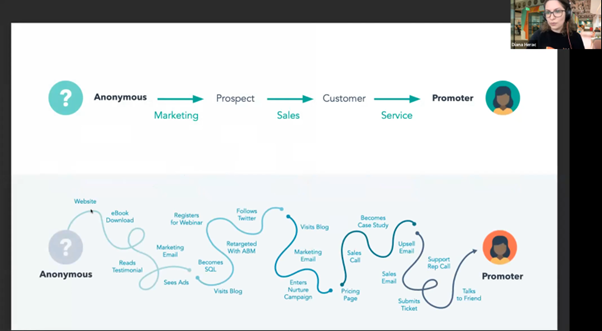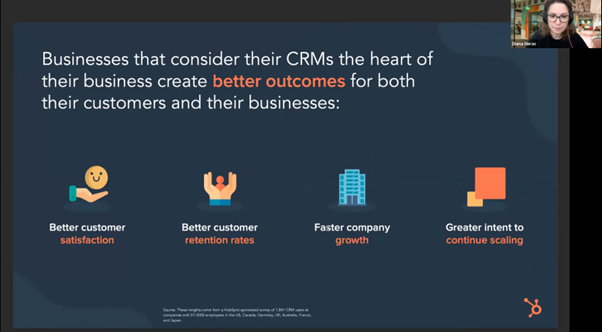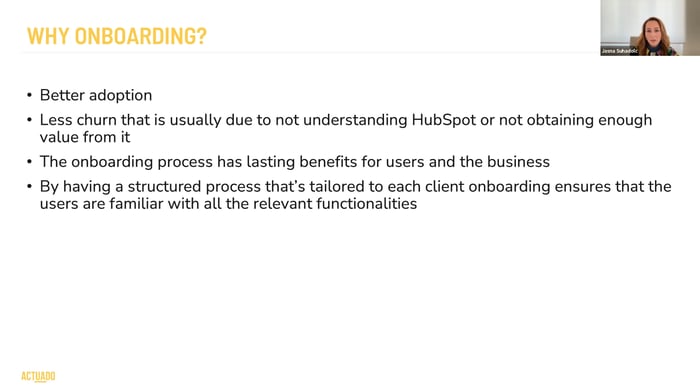Zapis je na voljo tudi v slovenščini
Consumer behavior has changed dramatically in recent years. Businesses were forced to accelerate the adoption of digital technologies, and as more and more consumer touchpoints move online, companies face the challenge of providing a consistent customer experience across a variety of channels.
Customer relationship management (CRM) software has thus become a vital tool for businesses, regardless of their size or industry. It helps optimize business processes, costs, and focus, and improve relationships with prospects and customers across the entire customer journey.
In our recent webinar, Diana Herac, Inbound Growth Specialist for CEE at HubSpot, explained the true power of CRM and shared some insider tips for choosing the right tool, and Ana Križmančič from Visionect rounded it out by sharing Visionect’s experience with onboarding with Actuado, a long-time HubSpot partner.
Sign up for the free webinar recording below, or keep scrolling to read our summary.
According to our quick webinar poll, the big majority of our live audience already has a CRM tool in place, but judging by their interest in the topic, they are not getting the results they expected. This is a common theme we see in our work with clients – they are often not happy with the CRM tool they are using, so they turn to us for help.
In our experience, the main reasons why companies struggle with getting value from their CRM are:
- using too many disjointed solution
- poor onboarding and implementation.
The customer journey is more complex than you think
Diana Herac has helped hundreds of businesses with their digital transformation process. She emphasizes that in this new landscape, CRM is no longer (just) a sales tool. It has become a business tool that connects the dots in the customer journey.
Think about it – your prospects and customers interact with you through multiple touchpoints. They see your ads on social media, check out your products on your website, download your e-book, register for your webinar, talk to your sales rep… The buyer’s journey is a complex, non-linear and unpredictable process.
 Customer experience: what you think it is vs. what it actually is.
Customer experience: what you think it is vs. what it actually is.
Your marketing, sales and customer service teams all play a role in addressing the various touchpoints on the customer journey and delivering a meaningful experience. To untangle the complexity, they are broken down into five core elements – content, messaging, automation, reporting, and data, Diana explains. There is a whole range of tools that can help you manage these elements, and companies often buy different tech solutions, layer them on over time and try to tie them together as they go.
HubSpot is different – their platform is built from the ground up and brings all the key components together under one roof, so you can have, as they say, “a single source of truth”.
Why is it better to have a unified CRM solution like HubSpot?
When marketing, sales, and customer service teams are using different, disjointed solutions, there are gaps in the customer journey, and you miss out on a lot of important information. Contrast that with the benefits of a unified system:
- A single source of truth (makes it easy to align). You have all the data in a single system, so you can connect all those different touchpoints to better understand your customers. Then you can make informed decisions and plan how to engage them and improve the sales process down the line.
- One intuitive UX (makes it easy to adopt). Instead of having to learn multiple systems, your teams have just one, easy-to-use platform that can be quickly adopted by all departments.
- A unified codebase (makes it easy to adapt). Not only does this make your IT team happy because it’s easier to maintain, it also makes for a better customer experience because data flows from one department to another in real time, allowing you to make more informed decisions and tweak your marketing efforts on the spot.
“Having this visibility across departments, a 360° image of your prospect – that is gold, it’s what’s going to put you in a better position relative to your competitors,” Diana says. She has some data to back that up – according to a HubSpot survey, companies that consider their CRM’s the heart of their business have:
- 8 times better customer satisfaction (CSAT)
- 3 times increase in customer retention rates
- 3 times faster company growth
- 9 times greater intention to continue scaling up

How to choose the right CRM for your business?
There are a few things to consider when choosing the right CRM software for your business' needs. To help with that, Diana explained to us the 3 C-s of a good CRM platform:
- Customization – it allows you to create the right processes and workflows within the system so that the tool fits your business like a glove.
- Connectivity – it allows you to share information from one department to another and with external systems, so you can identify opportunities and pain points of your customer base.
- Customer-centricity – it allows your marketing, sales, and customer service teams to put customer satisfaction at the center of their activities and create a seamless customer experience, from the prospect’s first contact with a marketing resource to the customer becoming an advocate for your brand.
Here are some questions you can ask yourself as you dive into the options:
- What does each team need to get their work done, and can you build bridges between departments?
- Will it be easy for everyone to use and adopt?
- Can it expand and grow with your business?
- How easily can it integrate with other solutions you already use or might need in the future?
The importance of custom onboarding
Everything mentioned so far is pointless if you don’t have impeccable execution and implementation of the CRM strategy, Diana Herac pointed out. This is where onboarding comes into play, so she handed the stage to Jasna Suhadolc, who shared a bit about how Actuado helps companies succeed with HubSpot’s marketing, sales, and services tools as a HubSpot Platinum Solutions partner.
Jasna emphasizes that custom onboarding and implementation are critical to the tool’s long-term success – regardless of which one you choose. First, this ensures better adoption and lower churn, so companies can leverage the value of a product they have invested time, energy, and money in. Second, the onboarding process has lasting benefits – recorded onboardings can be viewed again and again by new employees. Third, a structured process that is tailored to each client ensures users are familiar with all the functionalities that are actually relevant to them.
Over the years, HubSpot has recognized poor onboarding as the number one reason companies experience problems with their platform, so they made onboarding mandatory for some of their software plans. You can do it in two ways:
- direct onboarding from HubSpot,
- onboarding with a HubSpot partner agency.
Both options have their benefits, but the main advantages of working with a partner agency are the tailored approach and ongoing support.
“We really get to know our clients,” Jasna says, “because we understand what they do, we can offer informed advice on why they need a certain functionality”.
 Jasna walked our webinar listeners through an example of Actuado’s onboarding process. It usually takes at least 8 weeks, but the duration depends on the client’s needs and goals, and the plan(s) they want to use.
Jasna walked our webinar listeners through an example of Actuado’s onboarding process. It usually takes at least 8 weeks, but the duration depends on the client’s needs and goals, and the plan(s) they want to use.
Ana Križmančič has first-hand experience with Actuado’s onboarding process. She is a Marketing Team Lead at Visionect, the the tech company behind the brand JOAN. Visionect initially decided to use only the Marketing and Sales Hubs, but later switched from Zendesk to HubSpot’s Service Hub as well. Ana recounts the obstacles that slowed down the process – the uncertainties related to the pandemic, the fear of losing data, time management and resource issues, the budgeting aspect… But in the end, everything worked out (thanks in part to HubSpot’s dynamic payment options), and Ana says that today, they couldn’t be happier.
 The client’s perspective: Ana Križmančič shares Visionect’s experience with onboarding.
The client’s perspective: Ana Križmančič shares Visionect’s experience with onboarding.
Ana says what she appreciated most about Actuado’s onboarding process was that it was really structured. “The whole structure was defined in advance, which made it very efficient. The more confidence we had with the tool, the more questions we had. Katarina was able to answer them while making sure that no time was lost.”
After working with us for over a year, Ana's team felt confident to take over themselves, but Ana is glad to still have us in the 'backup role'.
When we completed the onboarding, we felt like teenagers – we thought we knew everything, but in reality, we didn’t. The year-long support was priceless, because that’s when the real questions come up. Having that continuous support is very valuable.”
Register and watch the recording:
If you wonder how Actuado can help you optimize your CRM and marketing automation strategy, schedule an appointment in our calendar – we will be happy to help you!



